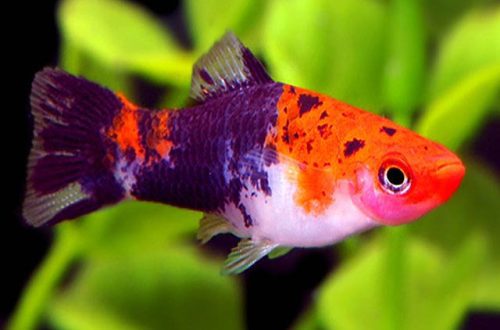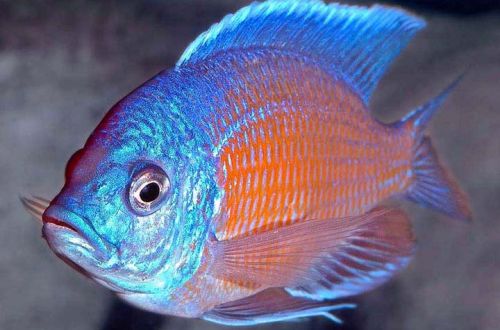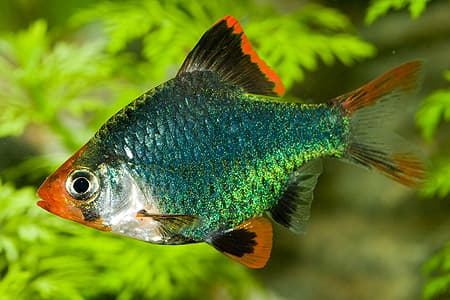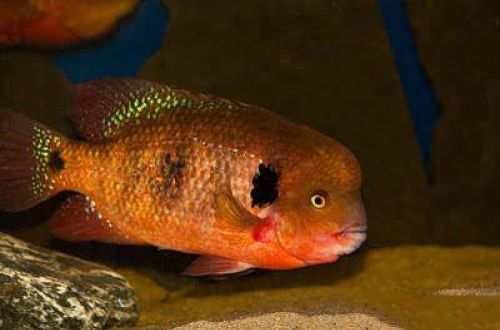
Theraps godmanny
Theraps godmanni, scientific name Theraps godmanni, belongs to the family Cichlidae (Cichlids). The fish is native to Central America. The natural habitat is limited to the river systems of Guatemala on the Atlantic slope. They inhabit fast mountain rivers with relatively cool water.

Description
In the wild, adults reach a length of up to 30 cm. In aquariums, they usually grow smaller – up to 25 cm. The fish has a high, somewhat compressed body from the sides. The caudal stalk is elongated and crowned with a small tail. The dorsal and anal fins are enlarged and noticeably shifted closer to the tail.
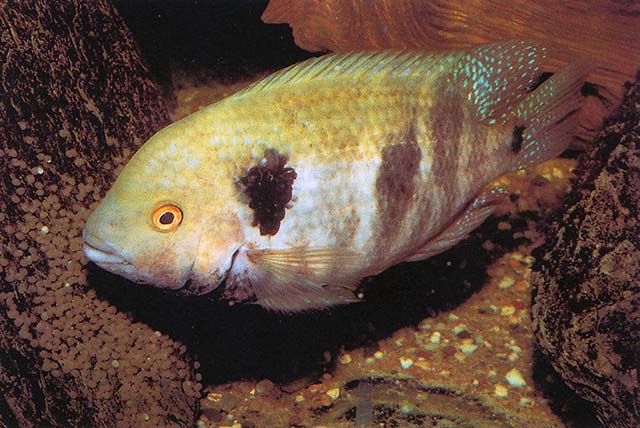
Females are larger and less brightly colored than males. The predominant shades of females are light beige, gray with a blue tint of scales.
Males are smaller, but brighter. Coloring intensifies during the breeding season, acquiring a rich red hue with turquoise scales. As they grow older, the so-called “occipital hump” grows – a bump on the forehead.
In the drawing of the body, a large black spot of irregular shape is noticeable, located behind the head. Pale dark vertical markings may appear on the caudal part of the body.
Behavior and Compatibility
Territorial aggressive species. Hostility intensifies during the breeding season. The teraps godmanni zealously protects its offspring and is able to injure a fish swimming inadvertently nearby.
In the limited space of home aquariums, it is not compatible with other species. As neighbors, only relatives can be considered, provided that each can form his own territory.
Brief information:
- The volume of the aquarium – from 150 liters.
- Temperature – 24-25°C
- Value pH — 7.0–7.6
- Water hardness – medium and high hardness (10-20 dGH)
- Substrate type — stony
- Lighting – moderate
- Brackish water – no
- Water movement is strong
- The size of the fish is up to 25 cm.
- Nutrition – any food containing plant components
- Temperament – territorial, aggressive
- Keeping alone and in pairs in a large aquarium
Maintenance and care, arrangement of the aquarium
For one fish, a tank of 150 liters or more will be required, for two more than 350. It is important that each adult has the opportunity to occupy its own area at the bottom.
The design should resemble the bed of a mountain river. The composition is based on large stones, boulders, driftwood is possible. Live plants are usually not used because they can be uprooted, damaged, eaten.
It is recommended to have several shelters in the form of artificial caves, stone grottoes in which neighboring fish could hide from each other. Thus, shelters will become the centers of their territories and, accordingly, should be located at a distance, in different parts of the aquarium.
An efficient filtration system or a separate pump can be responsible for simulating a turbulent flow. The first option is preferable because the filter performs two functions: water purification and flow creation.
Depending on where the fish is imported from (wilderness or hatchery), keeping conditions can be more or less stringent in terms of compliance with hydrochemical parameters. Before purchasing, it is necessary to clarify the features of the content with the supplier / seller and recreate the composition of the water in your aquarium as closely as possible.
Food
They will accept most popular feeds in dry, frozen and live form. It is important to regularly add plant-based foods such as blanched vegetables (peas, spinach, Brussels sprouts, etc.) and spirulina flakes.



